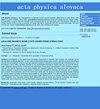具有强汤川相互作用模型的动力学对称性破缺
Q4 Physics and Astronomy
引用次数: 2
摘要
本文的主要目的是探讨强汤川动力学下自发对称性破缺的可能性。从技术上讲,对称性被假设是由标量和费米子传播子的对称破坏部分的形成而打破的,而不是由标量真空期望值打破的。这个想法首先是在一个玩具模型的例子中引入的,这个模型的基本对称是阿贝尔对称,后来被应用到一个现实的电弱相互作用模型中。此外,本文还讨论了一些更一般的、与模型无关的问题,这些问题不仅适用于所讨论的强汤川动力学模型,而且适用于更广泛的具有动态质量生成的模型。首先这些问题是费米子风味混合的问题,在费米子自能存在的情况下,具有一般的动量依赖。特别说明了如何在这种模型中定义Cabibbo-Kobayashi-Maskawa (CKM)矩阵,并论证了它原则上可以是非酉的。第二个问题是计算当对称性被费米子自能打破时规范玻色子质量的问题。除了推导规范玻色子质量矩阵的公式外,我们还找到了对相关的Pagels-Stokar公式的修正。本文章由计算机程序翻译,如有差异,请以英文原文为准。
Dynamical symmetry breaking in models with strong Yukawa interactions
The primary aim of the thesis is to explore the possibility of spontaneous symmetry breaking by strong Yukawa dynamics. Technically, the symmetry is assumed to be broken by formation of symmetry-breaking parts of both the scalar and the fermion propagators, rather than by the scalar vacuum expectation values. The idea is first introduced on an example of a toy model with the underlying symmetry being an Abelian one and later applied to a realistic model of electroweak interaction. In addition, the thesis also deals with some more general, model-independent issues, applicable not only to the discussed model of strong Yukawa dynamics, but to a wider class of models with dynamical mass generation. First of these issues is the problem of fermion flavor mixing in the presence of fermion self-energies with a general momentum dependence. It is in particular shown how to define the Cabibbo-Kobayashi-Maskawa (CKM) matrix in such models and argued that it can come out in principle non-unitary. Second issue is the problem of calculating the gauge boson masses when the symmetry is broken by fermion self-energies. On top of deriving the formula for the gauge boson mass matrix we also find corrections to the related Pagels-Stokar formula.
求助全文
通过发布文献求助,成功后即可免费获取论文全文。
去求助
来源期刊

Acta Physica Slovaca
物理-物理:综合
CiteScore
0.30
自引率
0.00%
发文量
0
审稿时长
>12 weeks
期刊介绍:
acta physica slovaca is an internationally recognised physics journal originally established in 1950. Since 1998 listed in Current Contents. Since 2006, acta physica slovaca publishes review and tutorial articles. Papers written by specialists in a given field are intended to be accessible also to non-specialists and PhD students. Although the printed version of the journal is available, all issues are free to download from the journal''s web page. We hope that the new issues of acta physica slovaca will be useful and interesting for readers.
 求助内容:
求助内容: 应助结果提醒方式:
应助结果提醒方式:


